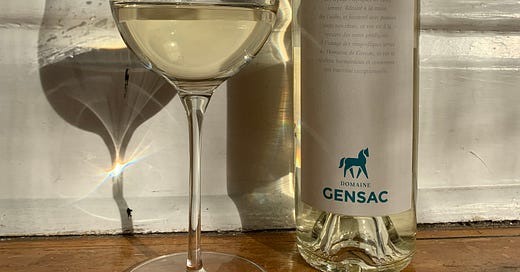What do we mean when we say a wine is "lean?"
In a new series, Off The Grid, I invite you to lean into more poetic approaches to talking about wine.
Reader, you know by now that I love a good series. This is the first of my new one: Off The Grid, where I ask wine professionals to break down common wine descriptors, then invite you to get more poetic with your wine descriptions.
What is the “grid”?
The “grid” refers to the wine-tasting grid: a standardized, measurable way to work through describing the sight, smell, taste, and texture of a wine. The grid was created by the Court of Master Sommeliers, and other credited institutions have their own version of it.
The grid gives us common ground to talk about wine, which can be really helpful. I’ve learned so much by using the grid to identify aromas. But it doesn’t come without problems.
Two things I learned at the Wine Writers’ Symposium, from listening to Elaine Chukan Brown on various panels. One: The Court of Master Sommeliers, WSET, and the Institute of Masters of Wine were all created by the same group of white men from London in a small window of time. We’ll also notice that the grid is highly Eurocentric.
It doesn’t make sense to base our entire way of talking about wine on the experience of any single group of people. Wine is as diverse as cuisine. Doing this brings up issues like: when you say exotic fruit, to whom is it exotic?
Another thing we kept coming back to at the Symposium was that language is inherently exclusive. It can’t help itself. And if you feel excluded (for example, you’ve never had a gooseberry but are feeling like you should really say “this wine tastes like gooseberry!) then expanding to other descriptors will help you.
Off The Grid will examine words that we wine professionals can often be found saying, but don’t really make sense until you taste enough wine and get to know the associations. Wine is a language. This series is designed to help you learn it, then grow it.
What does “lean” mean?
As an adjective, lean is defined as “lean meat” or “containing little or no fat.” I like to tell people that I use lean to describe wine in the same way I would describe fish or meat. Lean is also defined as “thin,” “lacking richness,” or “having a high proportion of air.” We can look at “lean” as a lightweight wine that feels physically lean in the mouth.
The wine-tasting grid does ask the taster to assess the weight, or body of the wine. In the wine world, we think of it how you would a glass of skim milk compared to a glass of whole milk. The whole milk can be considered “full-bodied” and the skim milk “light-bodied.”
The skim milk might also be described as “lean.”
Wine professionals weigh in on “lean”
I put out a survey on my Instagram stories and got plenty of responses. Here is what some wine professionals mean when they describe a wine as “lean.”
Cassandra @casscharlick: “It’s linear. Slender. not generous or fat. Sometimes it is simple and slick.”
Chloe @malijenovskyca: “Not full-bodied.”
Yulia @yuliaezhikova: “The opposite of full when we’re talking about mouthfeel. Lean as in skim milk / full cream.”
Sydney @oheyitssydney : “It tastes straightforward, succinct almost, but also sometimes thin in viscosity.”
An invitation to lean into poetry
Two new words emerged that I really enjoyed from this survey: linear and succinct. “Succinct” is defined as “briefly and clearly expressed,” and commonly used to describe language. Something written, something spoken. If you want to use “succinct” to describe a wine, you might be describing it as lean, light, simple, and approachable.
But you will, in the same breath, be referring to the wine as a verbal expression, as a piece of spoken word, or even as a statement of purpose. What happens when we think of a glass of wine as a manifesto? What does the manifesto contain? What’s the message, in wine form?
Succinct first appears in the early 15th century, from Latin succintus. It’s initially used to describe how we adjust our clothes. “Having one’s belt fastened tightly,” or “contracted, short.”
This definition kind of relates to the other word that caught my eye: “linear.” Linear is to the point—no straying from the path. The belt is fastened; no martini in between adjustments. Although “linear” doesn’t refer to time in the way that “succinct” does, it does refer to a progressive movement of steps, from one to another, and I personally think that time is present here.
Time plays a role on the grid too. The grid often refers to the “finish” of a wine. After you swallow (or spit), does it linger in your mouth? Or is it gone as quickly as it appeared? A long finish that leaves a trace of smoke might not be so linear. Was the smoke there on the front? No…it was all tart cherry.
A linear wine might move through aromas unsurprisingly to the taster, not a plot twist to be found. Perhaps “linear” allows us to describe a wine the way we would a narrative, and again acknowledges that wine is a story. What is the arc? What is the message?
This is the poetic space that moving “off the grid” allows us to do. I want to invite you to consider whether a wine is lean or not, and to think about the tasting experience in terms of a narrative arc. Does it remind you of a book you’ve read? Why?
Upcoming Events in Charlotte
Seats are limited! Click here to book yours.
5/6 3-4pm French Wines Corkscrew Wine & Shop
5/20 3-4pm Riesling Lovers Corkscrew Wine & Shop
6/3 3-4pm I Can’t Believe It’s Not Chardonnay! Corkscrew Wine & Shop




